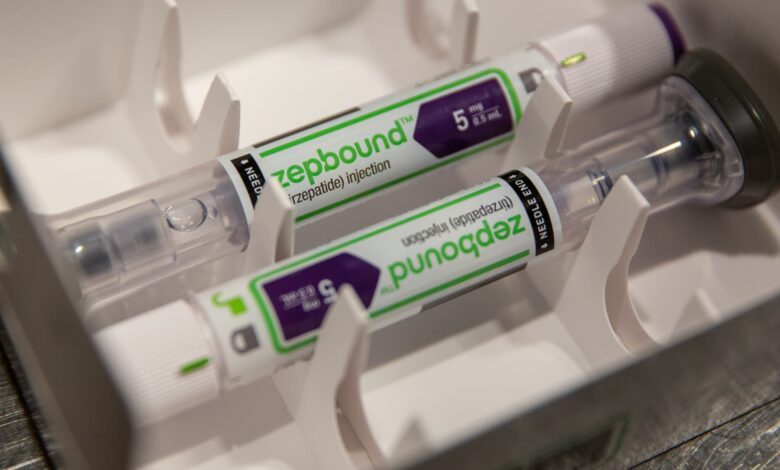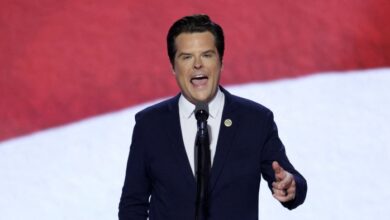
Investors want to know if Eli Lilly is seeing the same pricing pressure on its hit weight-loss drug Zepbound that Novo Nordisk experienced with its competing drug Wegovy in the second quarter. Novo Nordisk shocked investors on Wednesday when the company’s latest results missed Wall Street expectations. Shares plunged, down 8%, after the company lowered its forecast for operating profit growth through 2024. Eli Lilly is scheduled to report its second-quarter results before the market opens on Thursday. Analysts surveyed by LSEG expect the drugmaker to earn $2.60 per share on revenue of $9.92 billion. Helping drive the expected revenue growth of nearly 19% from the second quarter of 2023 is demand for Lilly’s GLP-1 drugs Mounjaro and Zepbound, also known as tirzepatide. But Novo’s results triggered some selling in Lilly shares on Wednesday, with the stock down 3%. While Eli Lilly’s stock is still up about 32% year to date, concerns about growing competition in the category have sent Lilly shares down nearly 16% over the past month. Analysts say the outlook for its obesity drugs will largely determine where the stock goes from here. LLY Mountain YTD Eli Lilly Stock Year to Date Why the Stock Is Under Pressure Novo Nordisk has been working hard to increase manufacturing capacity for its popular GLP-1 drugs and expand access to Medicaid patients. Management says both efforts will help the company’s long-term growth, but they have dented its near-term performance. Eli Lilly is making similar efforts with Zepbound, but its launch is at an earlier stage than Wegovy. Sales of Novo’s diabetes drug Ozempic rose 4% in the second quarter from the first, while Wegovy’s revenue rose 24% from the previous quarter. However, Wells Fargo analyst Mohit Bansal noted that prescriptions for Ozempic rose 17% in the second quarter, while prescriptions for Wegovy rose 58% in the same period, according to IQVIA. In part, Wegovy’s net price is falling due to efforts to expand access to Medicare patients in 20 states. While patients on the federal health insurance program typically don’t get coverage for weight-loss drugs, the Food and Drug Administration has approved Wegovy as a way to prevent heart attacks and strokes in people with cardiovascular disease who are overweight or obese. The ruling opens the door to expanded coverage. “They [Novo Nordisk management’s] “We are focused on securing supply to reach as many patients as possible and are mindful that prices typically fall as volumes increase,” Bansal wrote in a research note Wednesday. Barclays analyst Emily Field told clients in a research note that she would be a buyer of Novo Nordisk shares on the dip. “Is this the perfect quarter we were hoping for? Not necessarily,” she said. “But at the end of the day, obesity is going to be a volume-driven market, and the overall message we got from the company this morning was that volumes are moving in the right direction.” Is pricing moving toward parity? It’s important to remember that Wegovy is priced higher than Zepbound. “It’s not yet known whether the additional rebates for Wegovy will drive the generic price down, or if it will just trend toward parity with Zepbound,” Bansal said, adding that demand for these drugs, which mimic the incretin hormone to suppress appetite and control blood sugar, remains strong. Bansal expects Lilly’s diabetes drug Mounjaro to grow 14% in volume from the first quarter to the second, while Zepbound’s volume increased 59% in the same period. But how pricing will change will come after the results are released on Thursday. Bansal said he expects both drugs to outperformestimates even as prices eased slightly in the quarter. “Ultimately, the overall demand environment for incretins continues to be very strong, with NVO increasing its FY24 top-line guidance by 2% at the midpoint after increasing 1% in the prior quarter,” he said. Lilly may also adjust its revenue guidance, especially given the manufacturing gains the company has made, which helped remove tirzepatide from the FDA’s shortage list. Manufacturing progress David Song, investment partner at Tema ETFs, said investors will also focus on any updates Lilly provides on the drugs it is developing. Song said Lilly has a “lead position” with orforglipron, an oral GLP-1 drug it is developing. However, there are other manufacturing updates that are highly anticipated in the second half of the year, including data from Amgen on MariTide and Novo on CagriSema. JPMorgan analyst Chris Schott expects health outcomes data for tirzepatide to be a major catalyst for Lilly’s stock in the coming months. “While there have been some early-stage pipeline updates from competitors in the obesity space, we do not see these agents as differentiated or capable of meaningfully dislodging market share, and our view that LLY and Novo will remain dominant in the incretin space remains unchanged,” Schott said. He expects Mounjaro and Zepbound to reach $16.5 billion in sales by the end of this year, rising to $27 billion by 2025. Sales will reach $36.5 billion by 2026.




